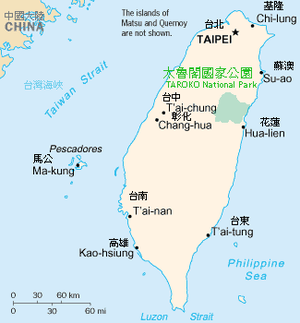Taroko National Park
Taroko National Park (Chinese: 太魯閣國家公園; pinyin: Tàilǔgé gúojiā gōngyuán; Pe̍h-ōe-jī: Taroko kok-ka kong-hn̂g) is a national park in Hualien County, Taiwan. It is the fourth national park in Taiwan ever created. It is the third-biggest national park in Taiwan. It features the Taroko Gorge.
| Taroko National Park | |
|---|---|
IUCN category II (national park) | |
 The Taroko Gorge | |
 Map of Taroko national park | |
| Location | Taiwan |
| Nearest city | Hualien |
| Coordinates | 24°10′N 121°20′E / 24.167°N 121.333°E |
| Area | 920 km2 (360 sq mi) |
| Established | 28 November 1986 |
| www | |
The park is well known because it has beautiful mountains and cliffs.[1]
History
changeThe meaning of "Taroko" is magnificent or beautiful in the Truku language.[2]
The area in and around the park was created by the Liwu River. The river slowly cut through the rock to create the gorge.[3]
The Atayal and the Sedek tribes came to the area over 300 years ago. Researchers found more than 70 villages from the tribes. There was a trail to Taroko called the Northern Road. The Qing Dynasty helped improve it. The Japanese then built a road system along the coast.[4]
Gold mining began in the area in the 17th century. It happened when the Dutch ruled Taiwan, during the Qing Dynasty, and when the Japanese ruled Taiwan. When the Japanese ruled Taiwan, they began mining the gold in the Liwu River. It began in 1918. There were plans to mine more gold in a shorter time, but World War II started and it didn't happen. Soon, when the Kuomintang ruled over Taiwan, they banned gold mining.[5]
The park was first created in 1937 when Taiwan was ruled by the Japanese. When they created it, it was called Tsugitaka-Taroko National Park.[2] When the Chinese government came back to Taiwan in 1945, they closed down the national park. In the 1950s, Chiang Kai-shek wanted a road that crossed Taiwan from west to east. In 1960, this road was opened, called the Central Cross-Island Highway. It runs through the Taroko Gorge.[6]
The park was created again in 1986. It was important because it showed that the Taiwanese government knew that they were damaging the environment.[7]
Geography
changeThe park has many rivers, waterfalls, and gorges. It has 20 kilometres (12 miles) of cliffs.[6] It also has 27 of the "100 Peaks of Taiwan", which includes Mount Nanhu. Mount Nanhu is 3,800 metres (12,500 feet) high and the fifth tallest mountain in Taiwan.[8] The area has a lot of marble and it also has the only jade found in Taiwan.[9]
The park is surrounded by the Pacific Ocean in the east, the Dajia River in the north, and the Zhoushui River in the west. The park covers around 920 square kilometres (360 square miles) of land and covers Hualien County, Taichung, and Nantou.[10]
The Taroko Gorge is 19 square kilometres (7.3 square miles) long.[2]
Climate
changeIn October to April, the temperature is around 20 to 30 °C (68 to 86 °F). In May to September, the temperature is around 30 to 40 °C (86 to 104 °F).[11]
Biodiversity
changeThere are 152 kinds of birds, 46 kinds of mammals, 35 kinds of reptiles, and 21 kinds of fish in the park. They include the Formosan wild boar and the Formosan monkey.[12]
Attractions
changeTaroko National Park has many monuments and attractions to help people learn about the Truku people and people that built the Highway. They include the Eternal Spring Shrine (also called the Changchun Shrine), and the Taroko village. In the park, many people come to hike. There are many hiking trails in the park.[2][8]
The Eternal Spring Shrine was built to honour the 226 people who died building the Central Cross-Island Highway. It has two waterfalls coming out from the building.[2] There are many hiking trails that begin there. There is also a cave with statues in it.[13]
References
change- ↑ "Taroko National Park". FamousWonders. Retrieved 20 November 2017.
- ↑ 2.0 2.1 2.2 2.3 2.4 Dimen, Yoshke. "8 Marble-ous Scenic Spots in Taroko Gorge, Taiwan". @thepoortraveler. Retrieved 17 November 2017.
- ↑ Lee, Derek (20 July 2005). "Going with the flow". Taipei Times. Retrieved 21 January 2018.
- ↑ "Taroko National Park". National Parks of Taiwan. Archived from the original on 23 September 2016. Retrieved 21 November 2017.
- ↑ "淘金夢". Taroko National Park (in Chinese). Archived from the original on 10 August 2017. Retrieved 17 November 2017.
- ↑ 6.0 6.1 "Taroko Gorge, The Most Beautiful Place of All Taiwan". taichung.guide. 15 October 2017. Retrieved 17 November 2017.[permanent dead link]
- ↑ "Introduction". Taroko National Park. Archived from the original on 6 January 2018. Retrieved 20 November 2017.
- ↑ 8.0 8.1 Shah, Anisha (7 July 2017). "Taroko Gorge: Taiwan's marble mountains". CNN Travel. Retrieved 19 November 2017.
- ↑ "Taroko National Park is a Taiwan Treasure". Global Travel Press. 19 January 2017. Archived from the original on 12 December 2017. Retrieved 18 November 2017.
- ↑ "Geogarphic Characteristics of Taroko National Park". Taroko National Park. Archived from the original on 14 July 2017. Retrieved 20 November 2017.
- ↑ "When is the best time to go to Taroko National Park?". Where and When. Retrieved 21 November 2017.
- ↑ "Fauna". Taroko National Park. Archived from the original on 26 October 2017. Retrieved 20 November 2017.
- ↑ "Eternal Spring Shrine". Atlas Obscura. Retrieved 21 November 2017.
Other websites
change- Official website Archived 2017-11-09 at the Wayback Machine
- Official website Archived 2020-07-26 at the Wayback Machine (in Chinese)